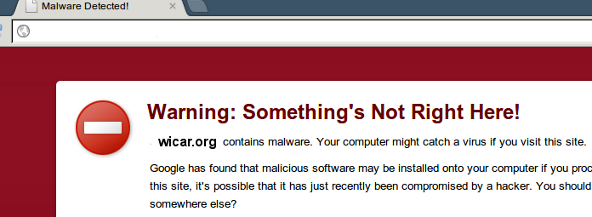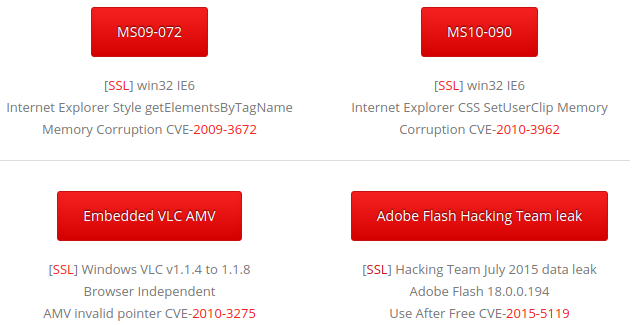|
Many of you would have seen our anti-malware solution test website known as WICAR (think EICAR AV Test File, but for web based attacks). This is just a quick email to let you know we now have SSL enabled for our test malware attacks, so not only can you test your firewall, IDS/IPS, proxies, content filtering and desktop antivirus, but you can also check if you are protected against payloads delivered over HTTP/S or verify your SSL-inspection products are working.
Simply open the Test Malware page and click the [SSL] hyperlink to conduct the test over SSL to ensure your organisation is adequately protected (most attacks today are delivered over SSL to get around proxy inspection). Recently, a client of ours requested some information regarding security considerations should a corporation permit employees to use social media such as Facebook, YouTube, Twitter and other sites.
It is a common problem. There are a few issues here which need to be considered; 1) Yes there are cross-site scripting issues with the websites. But the vulnerabilities are in the websites themselves, so youtube.com, facebook.com and twitter.com are managed by internal staff - if they are vulnerable then everybody is. It is really out of your control. The worms use to propagate, such as the recent Facebook worm which was posting adult images, abuse the [zero-day] vulnerability in the website... eventually the sysadmins discover the worm and close the gap. 2) The web browsers also play a part in exploitability. Internet Explorer 8+ has some mitigations for XSS. Chrome and Firefox also have some anti-XSS measures, but still lack complete protection. NoScript add-ons can be used for Firefox and Chrome to further mitigate attacks. Earlier browsers such as IE6 and older releases of Firefox interpret HTML and JavaScript differently, as well as Content-Type / Content-Disposition which may make a user of IE6 vulnerable to a facebook worm but not say IE7. So up-to-date SOE browsers are a good idea depending on what your patching is like. 3) When using XSS attacks the attacker or worm often needs a location to store their malicious JavaScript. NoScript will deny external locations unless explicitly permitted. But regardless, attackers sometimes use what would be considered trusted websites... so it is possible for someone to obtain a Google Sites account, upload JavaScript, then the browser will fetch the content from *.google.com ... instead of a suspect .cn domain etc. 4) There is the crossdomain.xml policy - http://www.adobe.com/devnet/articles/crossdomain_policy_file_spec.html. This is dependent on the website. 5) Researchers occasionally uncover browser vulnerabilities which breach the internal browser cross-domain security policy... so the result may be a vulnerability despite proactive protections and hardened configuration. 6) Antivirus vendors such as TrendMicro provide browser add-ons which check and report all URLs accessed by clients world-wide. The Trend Micro Threat Intelligence cloud and other reputable AV companies will notice the worm after a handful of end-users report the malicious action of a site. In this case, a few users will be infected but after the cloud picks up on this, the URL will be blacklisted globally until the threat is eliminated, thus protecting end-users providing you're not the first few visitors to be infected. 7) Obviously if you have a HTTP AV / Content Filter proxy then this may detect some worms. So to summarise, there are many different preventative measures you can take to avoid infection. Implementing all of the above may significantly reduce your risk, but after all is said and done, if the youtube.com / facebook.com / twitter.com domains are vulnerable, you are waiting on them to provide a fix. If there is a known, unpatched worm spreading and the media has alerted users like the recent facebook adult photos and dead animals worm, you could temporarily ban access to those sites on the firewall until the worm is cleared to try and protect staff. Another matter worth considering is whether there is a risk of staff seeing objectionable material such as pornography from the worm and the staff going on stress leave, workers compensation or suing for psychological damages etc etc. Some organisations try to minimise law suits by implementing strict policies about what to do when someone sends you pornographic material and you unexpectedly open it. There is paper work to complete including who sent the email (they are permanently added to a blacklist), listing all who received the email, any 3rd parties that saw it on your screen, ensuring that email archive / data backup staff store the offending email if needed for court on tape, and email admin staff forcibly deleting copies from staff inboxes by conducting email audits. Hopefully this gives you some insight into corporate considerations prior to blanket access of social media websites for staff. Introduction
The portal requires users submit a username and password to authenticate. This communication is not encrypted. Method Check the HTML source code on the form page, and examine whether the FORM ACTION is GET/POST to a HTTPS:// URI. Recommendation 1) Enable SSL and disable HTTP for the portal 2) Use two-factor tokens (one time password) for strong authentication. 3) Modify the HTML source to ensure the data is POST'ed to a HTTPS URL. |
Archives
September 2017
Categories
All
|
|
|
|




 RSS Feed
RSS Feed









